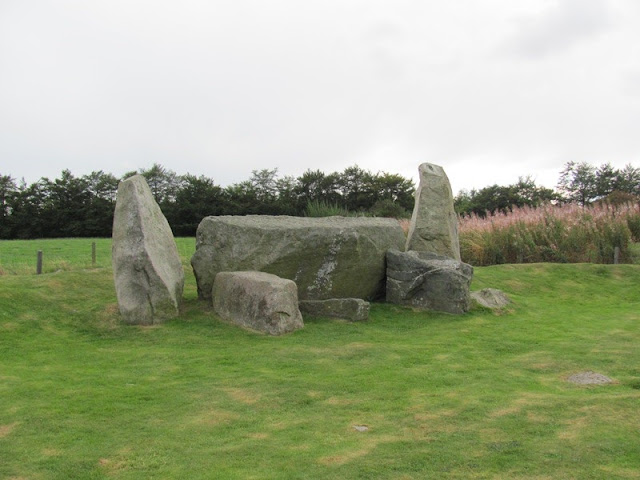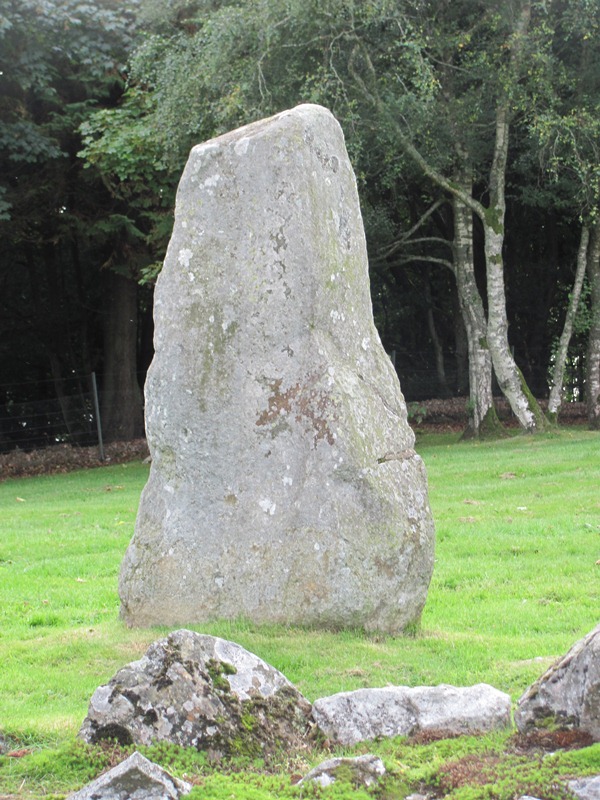On either side of Inverurie in Aberdeenshire there are two superb stone circles. The first of these is the Easter Aquhorthies stone circle. It's around 5000 years old but at some point inbetween, the dyke has been built around the outside of the circle. It has been suggested that this site had a spiritual significance long after the original builders and their purpose had been forgotten, for then name Aquothorthies is thought to come from the Gaelic for Prayer field. These sites of course still have a great spiritual significance for a lot of people today, so why not at any other point in the past.
There is a special feature of both the circles appearing here today that only appear in the North East of Scotland and that is the large flat stone lying on it's side. It is flanked by two uprights. There are 99 circle sites identified (some no longer existing) in the area dating to around 3000BC which are thought to exhibit this feature. The recumbent stones are always to be found in the South West parts of the circles and they seems to particularly well positioned for observations of the moon.
Most of the stones in the circle are of grey and pink granite but this one is a red jasper stone.
The Loanhead of Daviot stone circles are a short drive to the other side of Inverurie. There are two circles right next door to each other in this field - one is a stone circle, much like the East Aquhorthies circle featuring the large recumbent stone in the South West and the other is an enclosed burial site.
In the centre of the stone circle is a circle of rough pavement (it is 5000 years old after all) There is a circular gap in the middle of it - the grey area in this picture (it looks to be fine gritty kind of material and can't possibly be the same age as the rest of the circle). A couple of years ago I visited the Kilmartin area (which it appears I have very negligently not blogged - I'll attend to that some time in the future when I'm back home) and saw the Temple Woods Stone Circles which this reminded me of. There were two of those too but both were definitely stone circles. At temple woods the circles are also paved though the stones in them are much looser, extend beyond the standing stones and look as if they may have been a cairn at some point - though perhaps that is the case here at Daviot and the stones have been taken away for building use. There is also a stone cist at Temple woods which contained cremated remains and it strikes me that this may also have been what originally occupied the grey area in the middle of the circle.
In the circle next to the stone circle, the low wall of stones you see are actually the fill of an ancient ditch. This seems to have been a cremation cemetery. In the centre of the circle was found the partially cremated remains of a man clutching a pendant and the remains of a further 31 people have been found including 8 children between 3 and 6 years old. These date to about 1500BC some time after the stone circle. Eleven of the cremations were discovered in pottery urns. Around 500BC, the site was used for metal working.
The large recumbent stone in this circle has been cleaved in two, perhaps this had some religious significance to the builders or perhaps at some point in the last 5000 years the frost has got into it and halved it.
There is a single boulder sitting a few yards from the circle, which may have some significance.
Just to give you an idea of the size of the stones. It's very nice to be found in the car park - not having to balance my camera on a rock to take my picture, sat nav navigation between circles, and company was greatly appreciated.
























5 comments:
Very interesting to read about theses stone circles and I enjoyed all the photos too. I think the history of them is fascinating and we always look out for stone circles or other kinds of ancient monuments where ever we go!
Fascinating. One cannot help but wonder what were the ancients thinking? Interesting as there seems no attempt to work the stone, but simply put it in place and leave it as is.
Louise, They're good things to keep an eye open for. My road map seems to be well marked with them but a OS map shows some areas of the country to be remarkable rich in prehistoric sites.
John, There is no way of know what it was all about in reality - leaves modern man with a huge spectrum to imagine what happened here.
There is some shaping of the large recumbant stone and those in front of it I think - after 5000 of wear and tear in the Scottish weather it can be difficult to see. But most it seems are just as found as you say. They are made of granite and they would only have stone axes at best to shape them with, which would be a huge job. Also why should the modern idea of square sides and flat surfaces be obvious anyway.
You're right Sandy, we can only speculate what was happening back then. Was it you who said the Cup and Ring marks were started by bored shepherds ?
I don't think it was Jim, does keeping sheep go back that far?
Post a Comment